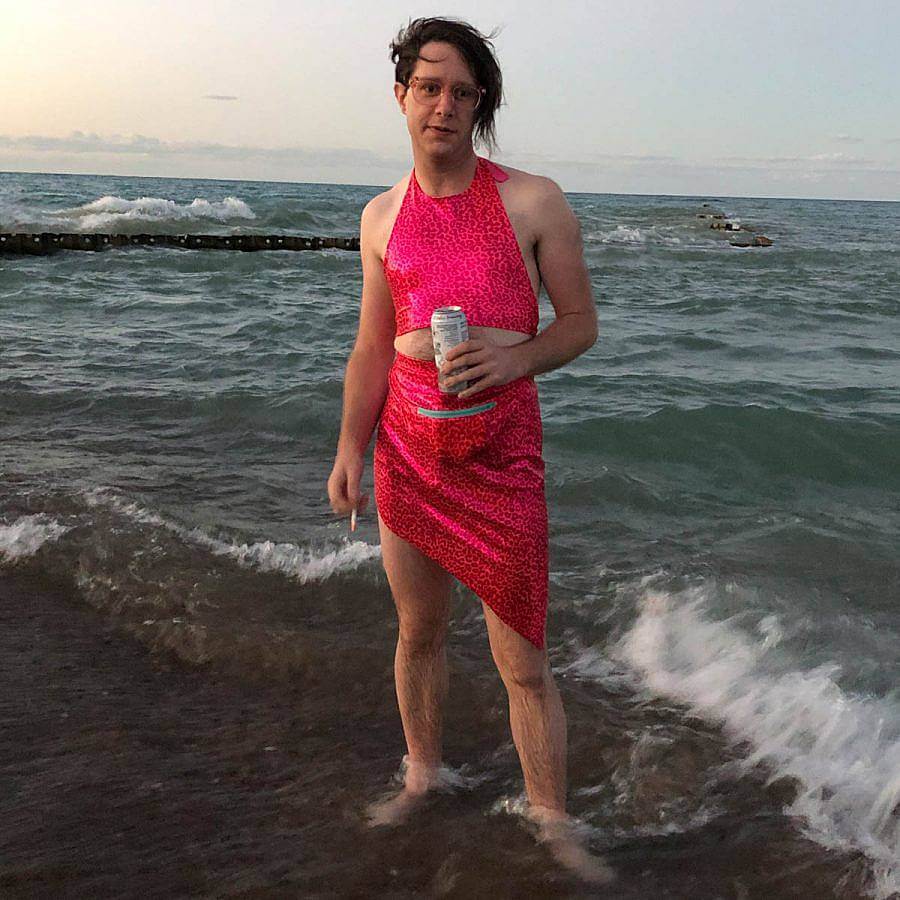Tell us a little bit about yourself and what you do.
I grew up in Evanston, which is a suburb of Chicago that has subway service but is also where John Hughes movies were filmed. Both my parents are art historians and like them I’m a very boring person, whose interests include geography and etymology, but unlike them I wear homemade vinyl clothes. I did my undergrad in New York, and hung around there until I moved back to Chicago for graduate school. I work with fabric to make partially-wearable, wall-hanging artwork, performances in that artwork, and abstractions that bridge photography and fabric collage.
What draws you most to wearable work and wall-hanging wearables?
Wearing a piece disturbs the sanctity of it; it can never be completely finished because it’s always in a contingent state. On the wall my work is very settled and intentional, but then I walk up to it and rupture that placidity by taking it apart and jumping inside. I can strike various poses, and I can pose the clothes on the support in different ways, thereby making the same piece look entirely different. A Formfit (my name for this body of work) has no fixed, final shape. There are very tactile explorations to be done in it, which transform it, and even risk damaging it.
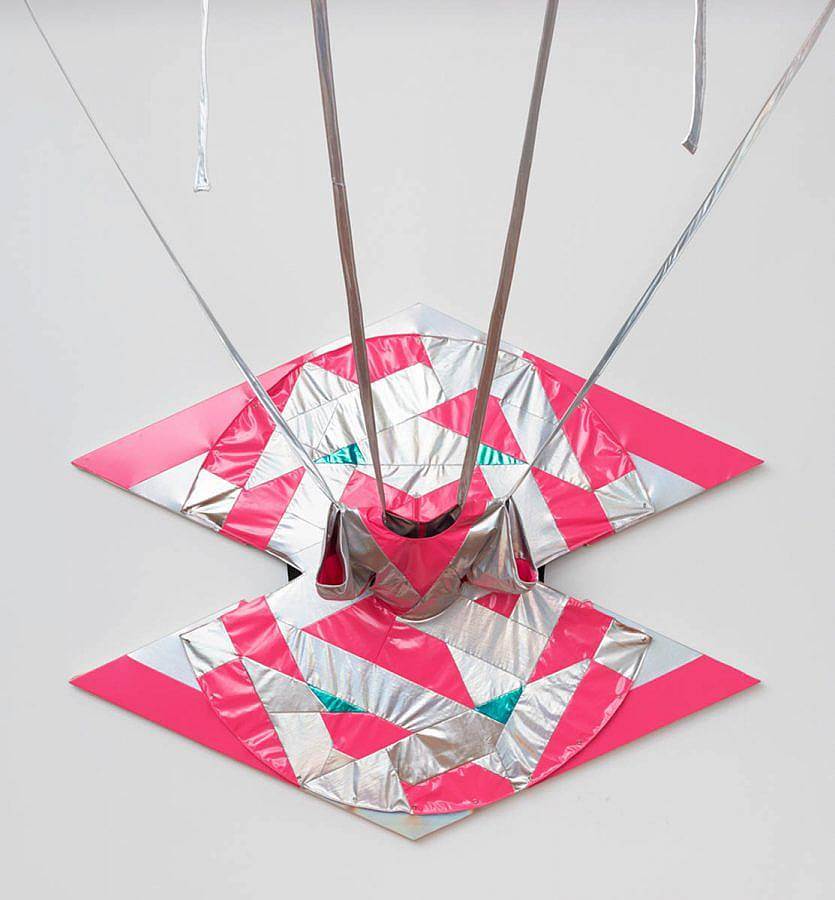
What inspired you to start making your own clothing?
I came to it pretty late, when I was in grad school. I’d always wanted to dress loudly, in shiny tight synthetic fabrics and mesh, but I was too timid to buy the clothes that I really wanted to wear. But at a certain point I started going to fabric stores, first Spandex House in New York, and then Textile Discount Outlet once I moved here, and I really wanted to do something with the fabric. After moving back to Chicago I started being more honest and open about who I was and how I wanted to present myself, and a big part of that self-creation was making clothes for myself. So I started making lots of skirts and leggings out of vinyl and spandex. I still sew things just to wear around, or to wear as matching undergarments for performances.

When sourcing materials, what are some of the first places you look?
I get most of my fabric from Textile Discount Outlet in Pilsen. It’s a wonderland of every sort of (inexpensive) fabric you could possibly want. When I moved back to Chicago I got an apartment less than a block away from them and their selection of deliciously bright, shiny, gaudy materials just fed this appetite in me that I’d had for a while. I think if I’d gotten a different apartment I’d be a completely different person today, and much less happy. Part of my process is wandering around the store seeing what jumps out at me, or what goes well together, so it’s hard to do remotely. I’d much rather run around a store feeling and comparing the fabric than order online.
Does color play an important role in your selection of materials?
Color is an enormous part of what grabs me when I’m looking for materials, as well as texture and sheen. Sheen makes the viewer aware of themselves in space relative to the fabric because the color isn’t fixed. Texture brings the viewer into the piece in a very corporeal way, by making them want to caress it. But part of what draws me to the fabrics I use is that their textures are so artificial and alien, so that urge to touch is ambivalent, because there’s also a bit of revulsion.
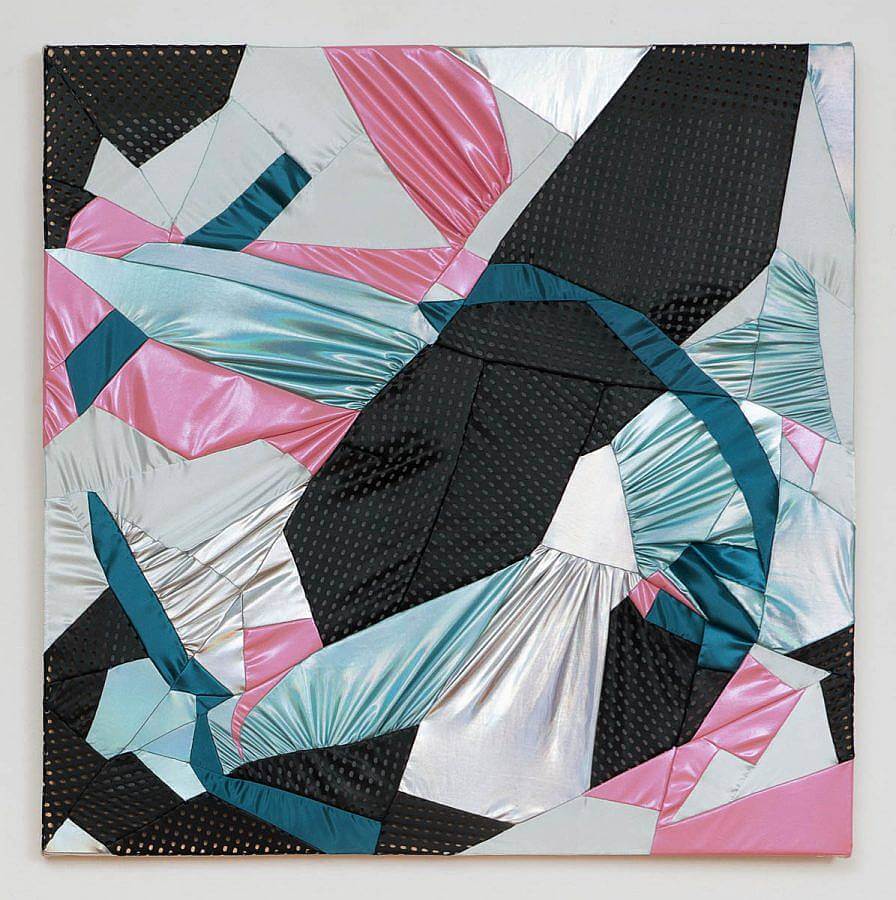
What is your process in beginning a composition, do you sketch it out prior?
My compositions almost always start with a fabric, or set of fabrics, that I want to work with, which is an intuitive decision. I’m just attracted to it, because it is, for instance, iridescent pink leopard print spandex, or wetlook vinyl that’s almost the color of my skin but a little too pink. Parallel to that I have a list of ideas for garments that I want to try. Both of these decisions are propelled by desire – I want a dress, and I want to wear hot pink and silver – but then when I make it as an artwork it thwarts that desire because it drastically reduces the number of situations in which I’d wear it. I don’t trust myself not to ruin my clothes/art so I only wear it very intentionally, mostly during performances. The garment is a link between the pure abstraction of its companion part and my body, between the two places that it may rest, and so the design is about bridging those two, and making something that is interesting to look at both when I’m wearing it and when it’s unworn.
I do sketch things out prior, trying to account for many different arrangements. I try to build ambiguity and contingency into my work by creating multiple ways for the parts to attach.
Many of your compositions convey fabric being stressed and tested. Does the treatment of the fabric play a significance in your work?
Part of what I like about fabric is how intrinsically unmoored and flexible it is. I want to keep that irresolution in my work but also arrest it to a certain degree, and by doing so bring attention to how protean it is. My assemblages are rather ad hoc – they’re designed, but they change every time that I set them up. Doing this on a wall means building in lots of different attachment points from which the piece fights against gravity.
I really enjoy what tension and compression do to textiles. When you apply compression, they resist and go from being two dimensional to folding in space in an uncontrolled way. And the heart of a lot of my work is trying to take something two dimensional and bring it into space.
There’s also a kinky aspect to it. My pieces come with a space for a body to fit into them, and then I strap the piece to the wall to keep it from moving. I don’t necessarily need to keep the garments as confined as I do, but that sense of constraint has to do with what I want my own empathetic feelings for the work to be. I’ve been meaning to have a fan blowing fabric in a piece for years now, and I keep dropping that idea in favor of new kinds of restraints. If I finally do it, it will either be only seen frozen in photographs or the fabric will be held taut. I can’t relate to a sheet just blowing around freely, that’s not how I feel or want to feel. It’s my art about me and I want to be strapped to a wall.
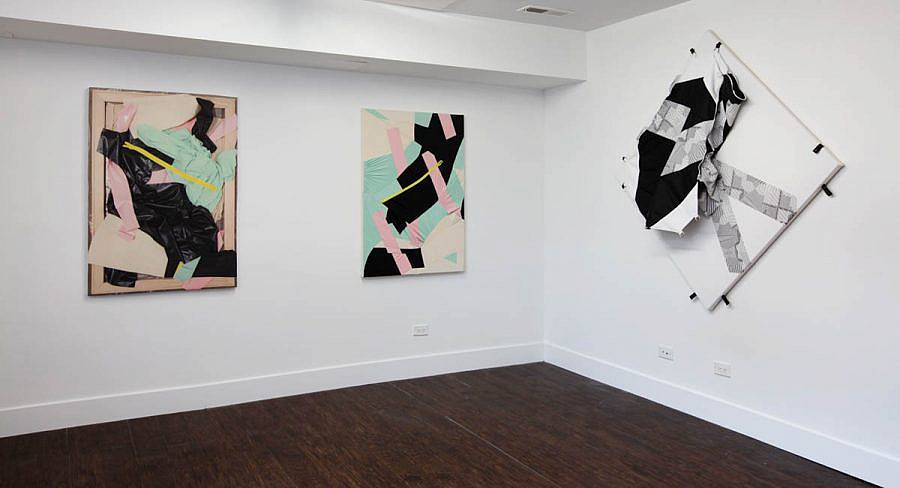
Recently, you’ve been performing with your work in wearable pieces you’ve made of the same fabric. Do you see the performance, clothing, and object all of the same work?
Being inside the piece transforms it completely for me; I become a part of it and look out from within in it, with the audience looking back at me. It can’t see the whole piece, only feel it around me. When unworn, the clothes blend in with their support, deconstructed and unfolded with zippers and snaps so that the whole thing becomes an abstraction. Pulling the clothing off breaks the piece apart. And because the garments are usually rather strangely constructed, a big part of the performance is just the process of separating the clothing and dressing in it. A lot of it is reversible, so I can try it on different ways, and pose in different ways, and the performance isn’t just me getting into the piece but me expanding and exploring it.
I only started performing during the pandemic, and I still haven’t done so in front of many people or posted any video documentation. But I intend to soon! I think it took having an excuse for doing it without an audience to actually take this final step. It’s something that I always wanted to do but it’s also scary to me.
I’ve set up a sort of performance space in my apartment, with three different wearable pieces in conversation, so now I can just do it whenever I feel like it and wear them around the house.
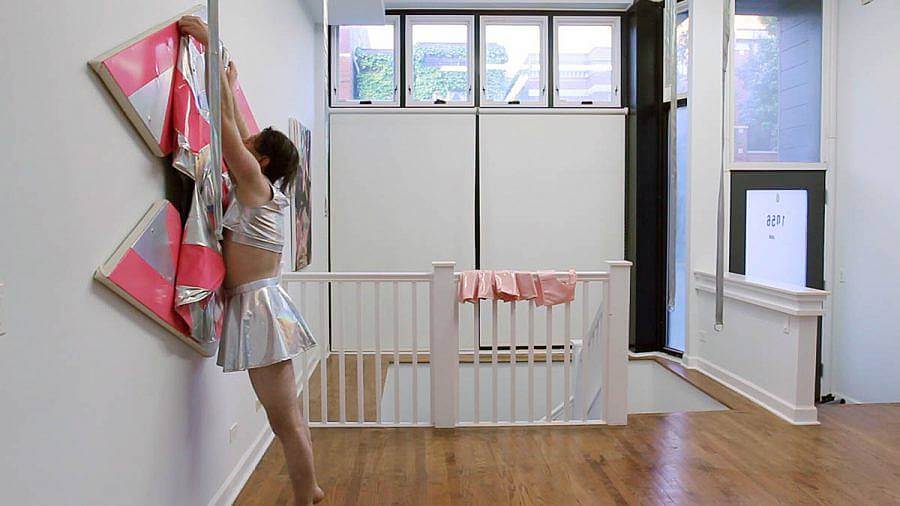
Can you talk about the pairing of your fabric assemblages with photographic prints?
I never like my art to have a single definite form. The photographs are each different possible manifestations of another “finished” piece, alongside of which they are shown. In each photo the heaped textiles form a different composition; I take one of them, which isn’t shown as a photograph, and sew the materials shown in it into a collage that mimics that arrangement. Once printed to scale on fabric and stretched, the photographs preserve the other forms that the final piece might have taken, making it less final. By using up the fabric there’s an indexical connection between the photographs and the sewn piece. But both the singular fabric work and the photographs have undertaken a transformation – the compositions that remain images are flattened and rendered illusionistic. But the one that was sewn together and thus realized is also flattened and simplified, and so transformed in the process. They’re both been fixed and lost something in the process, but in divergent ways.
The fabric heap comes from how I start a piece. They’re just piles of fabrics that I like, arranged until they make an abstraction that I like. It’s a very dumb thing that gets to the heart of what I love about art, namely finding astonishing beauty in a seemingly random arrangement of objects. From there the whole process is about coming to grips with how fleeting and random that moment of beauty is.
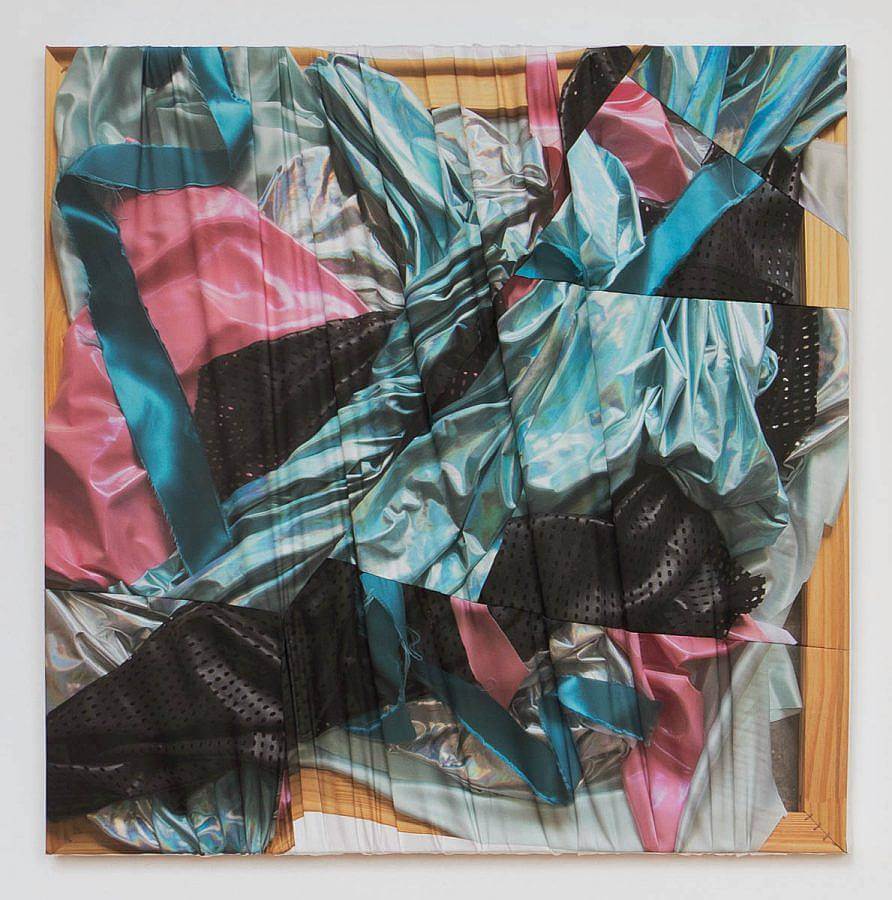
Tell us about your collaboration with Katie Hubbell, what are you working on?
Katie and I are going to have a show together at Random Access in Syracuse, New York in a few months. We’d been talking about collaborating for a long time, since our work seems so complementary – our styles fit together, and she does video and makes sculptures whereas I make performances and, well, costumes. The tricky part is that I’m in Chicago, she’s in Philadelphia, and the show is in Syracuse, and we’re all stuck in place because of Covid. So the plan is to work together remotely on a remote show, and that distance is the seed of what we’re doing. We’ve been recording ourselves talking to ourselves, and done readings of our texts back and forth over Zoom. We’ve got matching outfits made out of fabric that I printed. We’re making our own printed fabric, using photos of objects she made, which will be sewn into more garments, and we’re going to have videos projected onto cut-outs. It’s weird and exciting and terrifying. Which is how I feel about most of my art.
Interview composed and edited by Kaitlyn Albrecht.
